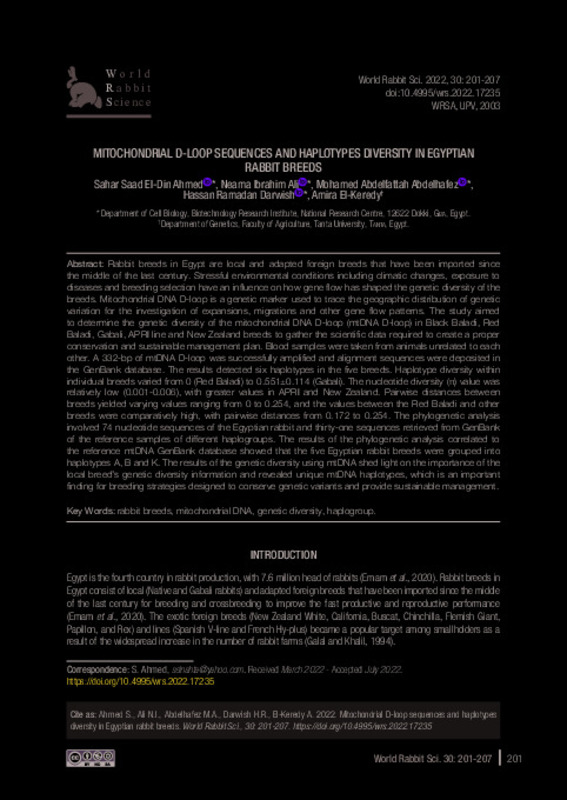Abou Khadiga G., Youssef Y.M.K., Saleh K., Nofal R.Y., Baselga M. 2010. Genetic trend in selection for litter weight in two maternal lines of rabbits in Egypt. World Rabbit Sci., 18: 27-32. https://doi.org/10.4995/WRS.2010.18.04
Ahmed S., Grobler P., Madisha T., Kotzé A. 2017. Mitochondrial D-loop sequences reveal a mixture of endemism and immigration in Egyptian goat populations. Mitochondrial DNA J. Part A, 28: 711-716. https://doi.org/10.3109/24701394.2016.1174225
Caird R., Jeffrey V., Kumar M., James R., Derek B., Harvey B., Mark B., Hans C., Archie C., Noelle C., Catherine E., Janet E., John L., Joan L., Holly N., Catherine P., Timothy P.L., Tad S., Jerry T., Bhanu T., Van E.,. Van T., Kevin W. 2019. Genome to Phenome: Improving Animal Health, Production, and Well-Being – A New USDA Blueprint for Animal Genome Research 2018–2027. Fron. in Gene., 10: 327. https://doi.org/10.3389/fgene.2019.00327
[+]
Abou Khadiga G., Youssef Y.M.K., Saleh K., Nofal R.Y., Baselga M. 2010. Genetic trend in selection for litter weight in two maternal lines of rabbits in Egypt. World Rabbit Sci., 18: 27-32. https://doi.org/10.4995/WRS.2010.18.04
Ahmed S., Grobler P., Madisha T., Kotzé A. 2017. Mitochondrial D-loop sequences reveal a mixture of endemism and immigration in Egyptian goat populations. Mitochondrial DNA J. Part A, 28: 711-716. https://doi.org/10.3109/24701394.2016.1174225
Caird R., Jeffrey V., Kumar M., James R., Derek B., Harvey B., Mark B., Hans C., Archie C., Noelle C., Catherine E., Janet E., John L., Joan L., Holly N., Catherine P., Timothy P.L., Tad S., Jerry T., Bhanu T., Van E.,. Van T., Kevin W. 2019. Genome to Phenome: Improving Animal Health, Production, and Well-Being – A New USDA Blueprint for Animal Genome Research 2018–2027. Fron. in Gene., 10: 327. https://doi.org/10.3389/fgene.2019.00327
El-Raffa A.M. 2007. Formation of a rabbit synthetic line (Alexandria line) and primary analysis of its productive and reproductive performance. Egypt. Poult. Sci., 27: 321-334.
El-Sabrout K., Aggag S., El-Raffa A. 2017. Comparison of milk production and milk composition for an exotic and a local synthetic rabbit lines. Vet. World, 10: 526-529. https://doi.org/10.14202/vetworld.2017.526-529
Emam A.M., Afonso S., Azoz A.A.A., González-Redondo P., Mehaisen G.M.K., Ahmed N.A., Ferrand N. 2016. Microsatellite polymorphism in some Egyptian and Spanish common rabbit breeds. In Proc.: 11th World Rabbit Congress, 15-18 June, Qingdao, China.
Emam A.M., Afonso S., González-Redondo P., Mehaisen G.M.K., Azoz A.A.A., Ahmed N.A., Fernand N. 2020. Status and origin of Egyptian local rabbits in comparison with Spanish common rabbits using mitochondrial DNA sequence analysis. World Rabbit Sci., 28: 93-102.
https://doi.org/10.4995/wrs.2020.12219
Excoffier L., Lischer H.E. 2010. Arlequin suite ver 3.5: a new series of programs to perform population genetics analyses under Linux and Windows. Mol. Ecol. Resour., 10: 564-567. https://doi.org/10.1111/j.1755-0998.2010.02847.x
FAOSTAT. 2010. FAO Statics Division.
FAOSTAT. 2013. Statistical Yearbook. World Food and Agriculture Organisation, Rome.
Galal E.S.E., Khalil M.H. 1994. Development of rabbit industry in Egypt. Cahiers Options Mediterraneennes (CIHEAM), 8: 43-56
Galal S., 2007. Farm animal genetic resources in Egypt: factsheet. Egyptian J. Anim. Prod., 44: 1-23. https://doi.org/10.21608/ejap.2007.93148
John S.W., Weitzner G., Rozen R., Scriver C.R. 1991. A rapid procedure for extracting genomic DNA from leukocytes. Nucleic Acids Res., 19: 408. https://doi.org/10.1093/nar/19.2.408
Kearse M., Moir R., Wilson A., Stones-Havas S., Cheung M., Sturrock S., Buxton S., Cooper A., Markowitz S., Duran C., Thierer T. 2012. Geneious Basic: an integrated and extendable desktop software platform for the organization and analysis of sequence data. Bioinforma. 28: 1647-1649. https://doi.org/10.1093/bioinformatics/bts199
Khader A.F., Abou-Steit T., Tharwat E.E. 2000. Characterization of the monthly reproductive performance of Sinai Gabali rabbit
does using New Zealand white rabbit as a reference breed. J. Agric. Sci. Mansoura Univ., 25: 4925-4932.
Khalil M.H. 1997. Model for the description of rabbit genetic resources in Mediterranean countries: Application to the Egyptian breeds Giza White and Baladi. https://agris.fao.org
Khalil M.H. 1999. Rabbit genetic resources of Egypt. Anim. Gen. Res., 26: 95-111.
Khalil M.H., Baselga M. 2002. Rabbit genetic resources in Mediterranean countries. Options Méditerranéennes. Série B: Etudes et Recherches (CIHEAM).
Long J.R, Qiu X.P., Zeng F.T., Tang L.M., Zhang Y.P. 2003. Origin of rabbit (Oryctolagus cuniculus) in China: evidence from mitochondrial DNA control region sequence analysis. Anim. Gene., 34: 82-87. https://doi.org/10.1046/j.1365-2052.2003.00945.x
Ministry of Agriculture and Land Reclamation in Egypt, FAO. 2003. First Report on the state of animal Genetic Resources in the Arab Republic of Egypt. FAO, Rome.
Nguyen N.T., Brajkovic V., Cubric-Curik V., Ristov S., Veir Z., Szendrő Z., Nagy I., Curik I. 2018. Analysis of the impact of cytoplasmic and mitochondrial inheritance on litter size and carcass in rabbits. World Rabbit Sci., 26: 287-298. https://doi.org/10.4995/wrs.2018.7644
Owuor M.A., Mulwa R., Otieno P., Icely J., Newton A. 2019. Valuing mangrove biodiversity and ecosystem services: A deliberative
choice experiment in Mida Creek, Kenya. Ecosyst. Serv., 40: 101040. https://doi.org/10.1016/j.ecoser.2019.101040
Pierpaoli M., Riga F., Trocchi V., Randi E. 1999. Species distinction and evolutionary relationships of the Italian hare (Lepus corsicanus) as described by mitochondrial DNA sequencing. Mol. Ecol., 8: 1805-1817. https://doi.org/10.1046/j.1365-294x.1999.00766.x
Rozas J., Ferrer-Mata A., Sánchez-DelBarrio J.C., Guirao-Rico S., Librado P., Ramos-Onsins S.E., Sánchez-Gracia A. 2017. DnaSP 6: DNA sequence polymorphism analysis of large data sets. Mol. Biol. Evol., 34: 3299-3302. https://doi.org/10.1093/molbev/msx248
Slaska B., Makarevic A., Surdyka M., Nisztuk S., 2014. Application aspects of animal and human mitochondrial genomics. Acta Sci. Pol., Zootechnica, 13: 3-18.
Tamura K., Nei M. 1993. Estimation of the number of nucleotide substitutions in the control region of mitochondrial DNA in humans and chimpanzees. Mol. Biol. Evol., 10: 512-526.
Tamura K., Tao Q., Kumar S. 2018. Theoretical foundation of the RelTime method for estimating divergence times from variable evolutionary rates. Mol. Biol. Evol., 35: 1770-1782. https://doi.org/10.1093/molbev/msy044
Youssef Y.K., Iraqi M.M., El-Raffa A.M., Afifi E.A., Khalil M.H., García M.L., Baselga M. 2008. A joint project to synthesize new lines of rabbits in Egypt and Saudi Arabia: emphasis for results and prospects. In Proc. 9th World Rabbit Congress 1637-1642.
[-]









